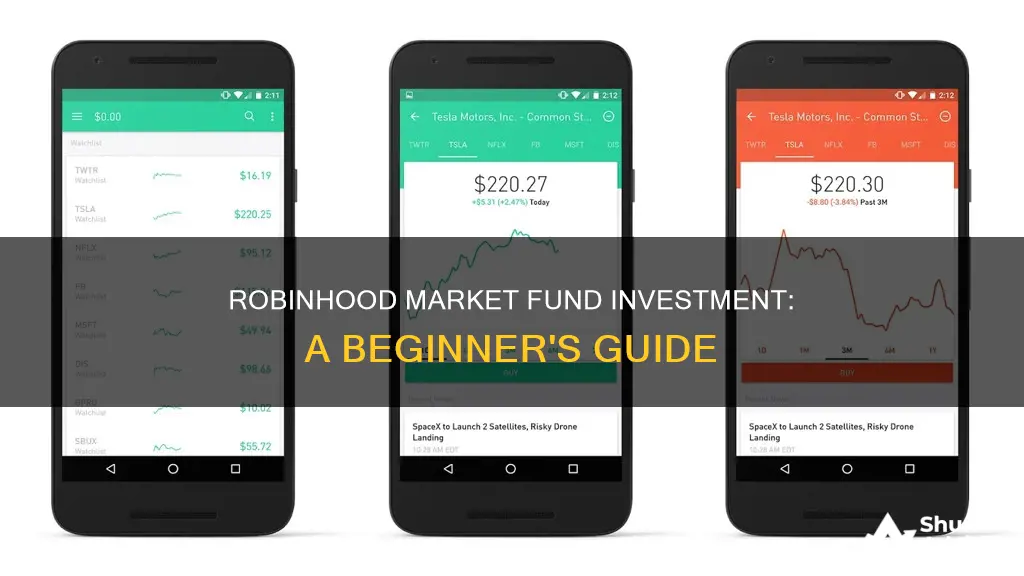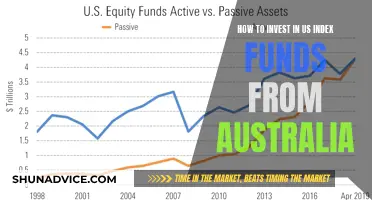
Robinhood is a commission-free trading platform that allows users to invest in stocks, bonds, exchange-traded funds (ETFs), cryptocurrencies, and more without going through a traditional brokerage. With a Robinhood investing account, users can access over 5,000 securities, including most U.S. stocks and ETFs listed on U.S. exchanges, as well as options trading and access to global stocks through American Depositary Receipts (ADRs). While Robinhood offers a wide range of investment options, it is important to note that it does not support mutual funds or bonds, which may limit the ability to build a diversified portfolio. Robinhood also provides 24/7 customer support and additional features through its Gold subscription, such as higher interest rates on uninvested cash and access to advanced market data.
| Characteristics | Values |
|---|---|
| Investment options | Stocks, options, ETFs, cryptocurrencies, ADRs, fractional shares, bonds (only in the form of ETFs), IPOs |
| Commission fees | $0 commission fee for stocks, options, and ETF trades |
| Account minimum | $0 |
| Interest rate on uninvested cash | 1.5% for free accounts, 5% for Gold accounts |
| Customer support | 24/7 in-app chat, phone support available from 7:00 a.m. to 9:00 p.m. |
| IRA match | 1% match on contributions |
| Crypto trading | Yes, for selected cryptocurrencies |
What You'll Learn

How to get started on Robinhood
Robinhood is a commission-free trading platform that allows users to invest in exchange-traded funds (ETFs), stocks, bonds, options, and cryptocurrencies without going through a traditional brokerage. Here is a step-by-step guide on how to get started with Robinhood:
- Sign Up: To start investing with Robinhood, you need to be 18 years or older, have a valid Social Security number, and a U.S. address. Simply sign up with your personal information, contact details, and Social Security number.
- Get Approved: After signing up, you will need to get approved by Robinhood. The company aims to notify customers of their approval status within an hour.
- Link Your Bank Account: Once approved, link your bank account to fund your investments. Bank transfers of up to $1,000 are available instantly for investing, while larger deposits may take a few business days to process.
- Start Investing: With your account set up and funded, you can begin investing in a variety of assets. Robinhood offers over 5,000 securities, including U.S. stocks, ETFs, options contracts, and access to global stocks through American Depositary Receipts (ADRs). You can also invest in cryptocurrencies through a separate account with Robinhood Crypto, depending on your location.
- Diversify Your Portfolio: It is important to diversify your investments to manage risk. Robinhood offers stock bundles and ETFs, which allow you to invest in a group of companies across different industries and sizes all at once.
- Set Investment Goals: Before you start trading, set clear investing goals. Determine the cost of your goal, the time horizon, the amount you have to invest, and how much you need to contribute regularly to reach your goal.
- Do Your Research: Familiarize yourself with investing news sites, financial planners, and fund performance updates to make informed investment decisions. Morningstar.com, for example, offers insights on fund performance, investment strategies, and fees.
- Practice with a Simulator: Consider using a stock market simulator to create a "practice portfolio" before investing real money. This will help you understand market fluctuations and develop healthy investing habits.
- Understand the Risks: Remember that all investing involves risk, and you could lose money. Always consider your investment objectives and risks carefully before investing. Options trading, for example, entails significant risk and may not be suitable for all investors.
Sovereign Wealth Funds: Global Investment Strategies and Secrets
You may want to see also

The risks of investing in market funds
Robinhood is a commission-free trading platform that allows users to invest in everything from stocks to options, exchange-traded funds (ETFs), and cryptocurrencies. While Robinhood offers a range of investment options, it is important to note that it does not support mutual funds or bonds. This lack of support for certain asset classes may make it challenging for investors to build a well-diversified portfolio.
Risk of Capital Loss
All investments carry some degree of risk, and investors can lose money in mutual funds. The value of your investment in a mutual fund can rise or fall due to various factors, and there is always the potential for negative financial outcomes. Market conditions, corporate decisions, and political events can all impact the performance of your mutual fund investments.
Inflation Risk
Even conservative investments, such as certificates of deposit (CDs), are subject to inflation risk. Over time, inflation can erode the purchasing power of your investment returns. If the return on your mutual fund investment does not keep pace with the rate of inflation, you may effectively be losing money in real terms.
Liquidity Risk
Liquidity risk refers to the ease or difficulty of converting your investment into cash. Some mutual funds may have restrictions or limitations on withdrawals, making it challenging to access your money when needed. It is important to understand the liquidity terms and conditions of any mutual fund before investing.
Concentration Risk
Concentration risk arises when you put all your eggs in one basket, so to speak. Investing in a single mutual fund or a small number of funds increases your exposure to risk. Diversifying your investments across different asset classes, industries, and fund managers can help mitigate this risk.
Low Returns
Mutual funds, especially those focused on low-risk investments, may offer relatively low returns compared to other investment options. While low-risk mutual funds can provide stability, the trade-off is often lower returns. It is important to weigh the level of risk you are comfortable with against the potential for higher returns when investing in mutual funds.
Fees and Expenses
Mutual funds typically charge various fees, such as management fees, transaction fees, and other expenses. These fees can eat into your investment returns over time, reducing your overall profit. It is crucial to carefully review and understand the fee structure of any mutual fund before investing.
In summary, investing in market funds, including mutual funds, carries several risks that investors should carefully consider. Understanding these risks and implementing appropriate risk management strategies, such as diversification and thorough research, can help mitigate potential negative outcomes.
Unlocking Investment Opportunities: Strategies for Securing Funds
You may want to see also

The benefits of investing in market funds
Robinhood is a commission-free trading platform that allows users to invest in everything from exchange-traded funds (ETFs) to cryptocurrencies without going through a traditional brokerage. While Robinhood does not offer mutual funds or bonds, it does support exchange-traded funds (ETFs) and American Depository Receipts (ADRs).
Professional Management
Investing in the stock market yourself requires deep knowledge. However, investing in a market fund doesn't require any knowledge as there is a fund manager to take informed investment decisions on the investors' behalf.
Low Risk
Market funds are considered very safe investments with low risk. Most investors have a low-risk appetite as it guarantees the return of their capital investment.
Fast Access to Cash
Market funds provide investors with the fastest access to their cash compared to other investment types. Depending on the fund, some can offer same-day or next-day liquidity.
Low Minimum Rate to Start Investing
Market funds require a low minimum amount to start investing. You can start with as little as $2,000, depending on the fund manager. Most other types of investments require a bigger amount to start.
Diversification
Market funds offer instant diversification among a range of securities. Investors don't have to select and invest in various securities individually. Diversification is an important safeguard for every portfolio.
Mutual Funds: Best 5-Year Investment Options
You may want to see also

How to make your first trade
Before you make your first trade, it's important to understand your motivation for investing. Ask yourself: Are you doing this to make some quick cash? Or are you interested in putting your money to work responsibly and thinking about long-term strategies? Knowing your motivation will help you stay focused on your financial goals and avoid making impulsive decisions.
Once you've established your motivation, follow these steps to make your first trade on Robinhood:
- Sign up for a Robinhood account: You need to be 18 years or older, have a valid Social Security number, and a U.S. address. Robinhood offers commission-free trading, so you can invest without paying any fees.
- Fund your account: Link your bank account to Robinhood to deposit money into your investment account. You can start investing with as little as $1.
- Choose your investment: Decide what you want to invest in. Robinhood offers a variety of assets, including stocks, exchange-traded funds (ETFs), options, and cryptocurrencies. You can also invest in fractional shares, which allow you to buy a portion of a share if you don't have enough money to purchase a full share.
- Do your research: Before making your first trade, take the time to research and understand the market and the investments you're interested in. Consider using a stock market simulator to create a "practice portfolio" to get a feel for how the market works.
- Place your first trade: When you're ready, go ahead and place your first trade on the Robinhood platform. Remember to start with a small amount of money that you're comfortable losing, and stick to stocks and ETFs if you're a beginner.
- Diversify your portfolio: It's important to diversify your investments to manage risk. Consider investing in a variety of industries and company sizes. ETFs can be a good way to invest in a group of companies all at once.
- Monitor your investments: After making your first trade, don't forget to regularly check on your investments. Stay up to date with investing news and analysis to make informed decisions about buying, holding, or selling.
- Seek guidance: If you need help, Robinhood offers 24/7 customer support and guidance for your first trade. You can also seek advice from independent financial analysts and advisors.
Remember, investing carries risks, and there is no guarantee of profits. Always do your own research and consider your investment objectives and risk tolerance before investing.
Investment Firm Fund Closures: Strategies Behind the Scenes
You may want to see also

How to diversify your portfolio
Diversifying your portfolio is a great way to help you mitigate losses and manage risks and rewards. Here are some ways to diversify your portfolio on Robinhood:
Identify your investor profile
Before you start diversifying your portfolio, it's important to ask yourself a few questions to understand your investor profile:
- What are your main reasons for investing? Are you saving for an emergency, paying off debt, or starting a retirement fund?
- How well do you tolerate risk? Are you willing to take bigger risks for bigger rewards?
- What is your investment timeline? Are you looking for short-term or long-term investments?
Choose your asset classes
Once you know your investor profile, you can start diversifying your portfolio by choosing different asset classes. Here are some examples:
- Stocks: These can be volatile, with the potential for high returns but also steep losses.
- Bonds: Generally considered safer than stocks, with lower returns.
- Cash and cash equivalents: Often considered the safest investment option, but typically yield lower returns.
- Real estate, commodities (like gold and oil), private equities, and more.
Diversify within each class
You can also diversify within each asset class by investing in different companies, industry sectors, geographies, and currencies. For example, you could invest in a mix of large, established companies and small-cap stocks or growth stocks.
Consider mutual funds or exchange-traded funds (ETFs)
If creating your own diversified portfolio feels too daunting, you can invest in mutual funds or ETFs. These are curated investment packages managed by professionals. Just keep in mind that they usually come with annual management fees.
Monitor and rebalance your portfolio
Over time, the value of your assets will fluctuate, changing your asset allocation. To maintain a diversified portfolio, you may need to rebalance by buying or selling assets to return to your target allocation.
Remember, diversification does not guarantee profit or eliminate the risk of losses. It's important to do your research and understand the risks and potential returns of each investment before adding it to your portfolio.
Fidelity Index Funds: Where to Invest Your Money Wisely
You may want to see also
Frequently asked questions
Robinhood offers commission-free trading, a streamlined interface, and access to over 5,000 securities, including stocks, options, and ETFs. It also provides 24/7 customer support and the ability to trade cryptocurrencies.
To start investing with Robinhood, you need to be 18 years or older, have a valid Social Security number, and a U.S. address. You can then sign up, get approved, and link your bank account.
All investing involves risk. Options offered through Robinhood Financial are risky and may not be suitable for all investors. Additionally, Robinhood has been criticized for its limited customer support and reliability issues.







